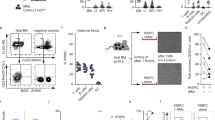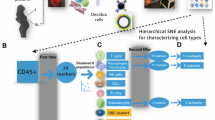Abstract
In recent studies, we showed that murine fetal liver cells from progeny exposed to benzo(α)pyrene in utero by intraperitoneal injection of the dam at midpregnancy (12 d) suppressed cell proliferation in an allogeneic mixed lymphocyte response. On the other hand, fetal liver cells from the corn oil (vehicle for the carcinogen)-exposed progeny (control) appeared to enhance proliferation. Suppression or enhancement appeared to be mediated by fetal liver bearing CD8+ and Lyt 1+ (CD5+) cells. Despite these manifestations, the role of third-party cells needs to be considered. As a first premise, adherent cells were targeted as possible third-party cells. To test the role of the adherent cells, liver cells from benzo(α)pyrene-exposed fetuses were treated with ficoll-hypaque, and the interface cells were fractionated through glass wool or nylon wool. It is known that adhering cells, macrophages and B cells, readily attach to glass or nylon wool. The effluent cells and the adherent cells were cultured with syngeneic responder cells and allogeneic stimulator cells in a mixed lymphocyte response. The results showed that benzo(α)pyrene-effluent cells led to the enhancement of proliferation in the mixed lymphocyte response, while benzo(α)pyrene-adherent cells led to suppression. The effluent and adherent cells of corn oil controls did not modify cell proliferation in the mixed lymphocyte response. These data suggest that a third-party cell, reasonably the macrophage or possibly B cells or both, since these are adherent cells, play a decided role in mediating suppression in the benzo(α)pyrene-exposed progeny.





Similar content being viewed by others

References
Bennett J. A.; Marsh J. C.; Mitchell M. S. Suppressor macrophages: their induction, characterization, and regulation. In: Chirigos M. A., et al. (ed) Mediation of cellular immunity in cancer by immune modifiers. Raven, New York1981.
Berland R.; Wortis H. H. Origins and functions of B-1 cells with notes on the role of CD5. Annu. Rev. Immunol. 20: 253–300; 2002.
Cone R. E.; Gershon R. K.; Askenase P. W. Nylon adherent antigen-specific rosette-forming cells. J. Exp. Med. 146: 1390–1404; 1977.
Folch H.; Yoshinaga M.; Waksman B. H. Regulation of lymphocyte responses in vitro. III. Inhibition of adherent cells of the T-lymphocyte response to phytohemagglutinins. J. Immunol. 110: 835–839; 1973.
Grimmer G.; Pott E. Occurrence of PAH. In: Grimmer G. (ed) Environmental carcinogens polycyclic aromatic hydrocarbons. CRC, Boca Raton, FL, p 61; 1983.
Handwerger B. S.; Schwartz R. H. Separation of murine lymphoid cells using nylon wool columns. Transplant. 18: 544–548; 1974.
Hecht S. A. Tobacco smoke carckinogens and lung cancer. J. Natl. Cancer Inst. 91: 1194–1210; 1999.
Julius M. H.; Simpson E.; Herzenberg L. A. A rapid method for the isolation of functional thymus-derived murine lymphocytes. Eur. J. Immunol. 134: 645–649; 1973.
Kizaki T.; Ookawara T.; Izawa T.; Nagasawa J.; Haga S.; Radak Z., et al. Relationship between cold tolerance and generation of suppressor macrophages during acute cold stress. J. Appl. Physiol. 83: 1116–1122; 1997.
Koide N.; Sugiyama T.; Mori I.; Mu M. M.; Hamano T.; Yoshida T., et al. Change of mouse CD5+ B1 cells to a macrophage-like morphology induced by gamma interferon and inhibited by interleukin-4. Clin. Diagn. Lab. Immunol. 9: 1169–1174; 2002.
Lee M. E.; Urso P. Suppression of T lymphocyte proliferation to antigenic and mitogenic stimuli by benzo(a)pyrene and 2-aminoflurene metabolites. Immunopharm. Immunotoxicol 29: 1–14; 2007.
Luch A. Polycyclic aromatic hydrocarbon-induced carcinogenesis—an introduction. In: Luchs A. (ed) The carcinogenic effects of polycyclic aromatic hydrocarbons. Imperial College, London, pp 1–18; 2005.
Moolenaar-Wirsiy P. J.; Wirsiy Y. G.; Urso P. Presence of CD4+ SP and DP (gd, ab) T-cells expressing BPDE-DNA adducts in progeny of mouse dams exposed to benzo(a)pyrene at mid-gestation. J. Immunotoxicol. 4: 267–277; 2007.
Ng D.; Kokot N.; Hiura T.; Faris M.; Saxon A.; Nel A. Macrophage activation by polycyclic aromatic hydrocarbons: evidence for the involvement of stress-activated protein kinases, activator protein-I, and antioxidant response elements. J. Immunol. 161: 942–951; 1998.
Peck A. B.; Bach F. H. A miniarized mouse mixed leukocyte culture in serum-free and mouse serum supplemented media. J. Immunol. Methods 3: 147–152; 1973.
Phillips D. H. Smoking-related DNA and protein adducts in human tissues. Carcinogenesis 23: 2197–2204; 2002.
Rahim R. T.; Meissler J. J.; Adler M. W.; Eisenstein T. K. Slenic macrophages and B cells mediate immunosuppression following abrupt withdrawal from morphine. J. Leukoc. Biol. 78: 1185–1191; 2005.
Santella R. M.; Hemminki K.; Tang D.-L.; Savelas K.; Vodickova L.; Dickey C., et al. Polycyclic aromatic hydrocarbon-DNA adducts in white blood cells and urinary 1-hydroxypyrene in foundry workers. Cancer Epidemiol. Biomark. Prev. 2: 59–62; 1993.
Singhal S. K.; Duwe A. K. Suppressor B cells. In: S. K. Singhal; N. R. St. C. Sinclair (Eds.) Suppressor cells in immunity, International Symposium; 1975; 12–18 pp, May 1975.
Thompson C. B.; Potter T. A.; MCKenzie I. F. C.; Parish C. R. The surface phenotype of a suppressor cell of delayed hypersensitivity in the mouse. Immunology 40: 87–96; 1980.
Urso P. CD8+, CD5+ normal mouse fetal liver cells enhance cell proliferation in the allogeneic mixed lymphocyte response: CD5+ fetal liver cells exposed to benzo(a)pyrene at mid-gestation are inhibitors. Immunopharm. Immunotoxicol.; 2008 (in press).
Urso P.; Gengozian N. Subnormal expression of cell mediated and humoral immune responses in progeny disposed toward a high incidence of tumors after in utero exposure to benzo(a)pyrene. J. Toxicol. Environ. Health 14: 569–584; 1984.
Urso P.; Wirsiy Y. G.; Zhang W.; Moolenaar-Wirsiy P. J. Alterations in CD4+, CD8+, Vg3, Vgd, and/or Vab T cell expression in lymphoid tissue of progeny after in utero exposure to benzo(a)pyrene. J. Immunotoxicol.; 2008 (in press).
van Grevenynghe J.; Snarfel I.; LeVee M.; Gilot D.; Drenou B.; Fauchel R., et al. Cytochrome P450-dependet toxicity of environmental polcyclic aromatic hydrocarbons towards human macrophages. Biochem. Biophys. Res. Commun. 317: 708–716; 2004.
Acknowledgments
This work was supported by grant no. PCE-5053-G-00-3062 from The US Agency for International Development and grant no. R815813 from the US Environmental Protection Agency. We thank Ms. Nicole Downing for editorial assistance and computer expertise.
Author information
Authors and Affiliations
Corresponding author
Additional information
Editor: J. Denry Sato
Rights and permissions
About this article
Cite this article
Urso, P., Kramer, M.K. The role of adherent cells in the immunosuppressed state of mouse progeny transplacentally exposed to benzo(α)pyrene. In Vitro Cell.Dev.Biol.-Animal 44, 273–279 (2008). https://doi.org/10.1007/s11626-008-9112-2
Received:
Accepted:
Published:
Issue Date:
DOI: https://doi.org/10.1007/s11626-008-9112-2



